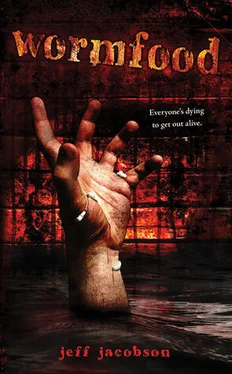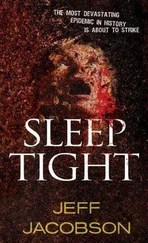I never liked using scopes. Looking through a scope always made me feel sort of disconnected from the rifle somehow. I felt much more comfortable sighting down the barrel, through the iron sights. It felt as if the rifle and I were working together, instead of screwing a chunk of glass on the top and using that to find your target. You never knew where the scope was aiming; if it was off just a little, you wouldn’t know it, you couldn’t feel it, but by sighting down the barrel, you knew roughly where you were putting the bullet. For long-distance shots, I used a pair of binoculars, just to double-check that the tiny brown blur in the distance was, in fact, a squirrel and not just a knotted root. Shells were too expensive to waste on killing a piece of wood.
The second reason was that using a scope felt too much like cheating.
The term “thirty-aught-six” simply meant that the rifle was a thirty caliber, that is, 308 thousandths of an inch wide, and the aught-six signified the year it was invented—1906. Besides loading her own shotgun shells, Grandma also kept me supplied with plenty of shells for the 30.06, using a 150-grain bullet, propelled by 52 grains of 4064 Dupont powder. This was a deer-hunting load, a huge load to inflict on the squirrels, but Grandma never changed or reduced it. For one thing, that was how Grandpa had set up his loading bench and dies, and Grandma got nostalgic about things like that.
The other was that she felt kind of sorry for the squirrels, even though they weren’t anything but country rats—these weren’t cute, fluffy gray tree squirrels, just disease-ridden rodents that lived in giant colonies of tunnels in the dirt.
“I won’t let them eat my garden, but I don’t see any need making ’em suffer either,” Grandma said.
Well, the squirrels sure didn’t suffer much when hit by a 150-grain bullet. They never even knew what hit them; the bullet usually just turned them inside out instantly. One second, they’re sniffing around in dust, and the next, they’re climbing that great oak tree up into the sky. They never felt much of anything.
Still, I can’t say I enjoyed killing them. I liked shooting, loved it, lived for it most days, but I never thought drawing blood when you pulled the trigger was much of a sport. It was too easy. I’d rather just throw some old golf ball as far as I could toward the foothills and shoot at that for a while. But we had to protect our food.
Grandma’s garden came first. And so, every month or so, I’d grab the Springfield and a box of shells and head into the knee-high Johnson grass beyond the garden to a level spot under the dead oak tree out in the middle of the field.
The tree was a monster; it had been out there forever. Lightning had struck it once or twice, and the branches grew out into the clouds in dizzying, twisted patterns because of the jolt. I don’t know what finally killed it. I like to think it was old age. It had been dead a couple of years now. The tree had also survived a few grass fires, and I could just make out the dim lines at various points along the thick trunk that spoke of floods in years past. Some of these lines were above my head.
About sixty yards past the tree to the north, the field dropped into a dry creek bed, nothing more than gray gravel and red mud. I’d never seen any water come down the creek, just puddles that collected after heavy rains. The foothills rose on the other side of the creek bed. This was where the squirrels lived. Over the years, before they built thedam and created the Stony Gorge reservoir, the creek had sliced chunks of the hills away, and now crumbling dirt cliffs rose out of the gravel, some nearly twenty to thirty feet high. Giant colonies of squirrels, some numbering into the hundreds, maybe even thousands, lived in there, in complicated mazes of holes that periodically opened out into the dirt face of the cliff. And there, when I walked out to the old oak tree, was where they died.
I leaned the rifle against the tree and studied the sky. No rain yet, but plenty of fat, angry clouds rolled across the low sky. I squatted down and got comfortable, mashing the tall grass down to form a cushion, my back to the tree, dirt cliff slightly off to my left. Sometimes, just to make things interesting and give the squirrels a sporting chance, I’d shoot standing, or off-hand as the old-timers called it, but today I was too damn tired and in too much of a hurry. I just wanted to kill a few squirrels and get to work before Fat Ernst got mad. Again.
I settled into the grass, feet planted firmly, knees bent at a 45-degree angle. If the holes in the cliff were at twelve o’clock, then I faced more or less toward the two o’clock mark. You always turn a little sideways to what you’re shooting so you can support the gun easier. If you face the target head on, then your left arm has to hang way out there, holding on to the end of the forestock, supporting the barrel. You can’t keep it steady. But if you turn sideways a little, then the rifle is resting across your chest, allowing you to draw your left arm in a little, so you can brace that elbow on something like, say, your knee if you’re sitting.
The key to holding any gun steady is in your posture. The idea is to build a series of solid supports, using your bones, locking them into place, from the ground up to the gun. I don’t care how strong you are, holding a rifle steady only using your muscles while firing at a target a hundred yards out is damn near impossible. You’ll shake too much. You need to relax those muscles, you need to be calm, breathing nice and slow and relaxed. Even your pulse can throw off your aim. It doesn’t have to be much. Moving the barrel a fraction of an inch could translate into missing the target by nearly a foot at a hundred yards.
My grandfather taught me everything about shooting. I can remember starting with a .22 when I was six, shooting at paper plates nailed to fence posts, then moving on up through .410 shotguns, and finally into larger rifles and shotguns like his 12 gauge pump Winchester and a .484 Remington. One summer evening, when the blazing sun had dropped halfway behind the coastal range to the west, when Grandpa and me were sitting under the same oak tree, watching for squirrels, he told me, “A gun is nothing more than a tool, but don’t forget that it’s nothing less than a tool either. Like any tool, a gun is only as smart as the person wielding it, but if you know what you’re doing, then a tool can move mountains. Squeezing the trigger is nothing less than imposing your will on the universe.”
I rested the rifle across my knees and fed five shells into the clip, loading them from the top, forcing them into the slot until I heard the click of the spring locking into place. When the clip was full, I took a deep breath, readjusted my knees slightly, and brought the binoculars up to my eyes, letting the air in my lungs out slowly and evenly.
The cliff face leapt into view with startling clarity. Sure enough, the squirrels were out and about, busily scurrying from one hole to the next in a flurry of motion one second, the next second freezing, watching, and listening—then another blur of motion. The trick was to nail them when they stopped to listen for predators. I suppose that’s kind of ironic, but they were just too damn hard to hit when they were moving. You had to factor in lead time and wind and all kinds of other damn things, and when I was pressed for time, I simply shot them when they were still.
The squirrels were all over the place. I could easily find them with my naked eyes, so I dropped the binoculars back to my chest, took another deep breath—settling in now, focusing my energy, quieting everything else down—and brought the rifle up to my shoulder. I pulled it in snug, because a 30.06 kicks like a mule that’s just been blinded with a faceful of pepper spray. You don’t really stop the recoil so much as rideit, guide it. I never braced myself against the tree, putting my shoulder between the stock and the trunk of the tree—I’d end up dislocating my shoulder or worse.
Читать дальше












